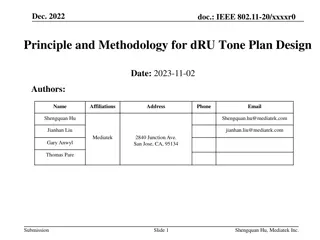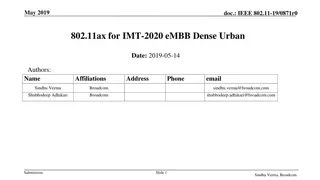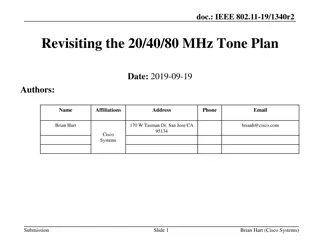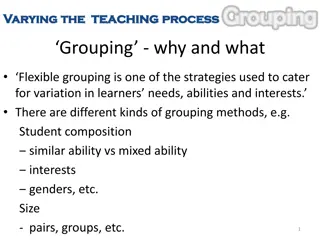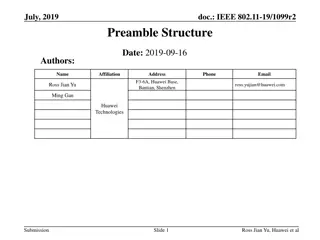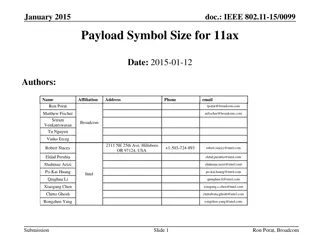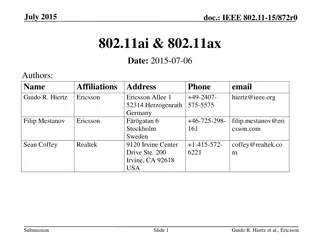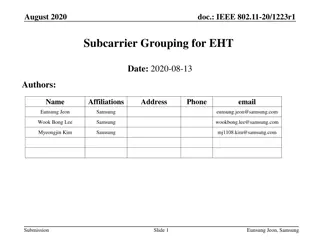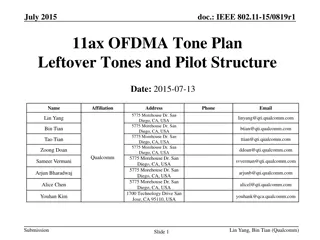
IEEE 802.11ax Maximum Tone Grouping Size Research
Explore the research on maximizing tone grouping size in IEEE 802.11ax for overhead reduction and improved feedback efficiency. The study investigates the impact of grouping parameters on performance in SU-MIMO-OFDMA and MU-MIMO-OFDMA scenarios, aiming to demonstrate overhead savings and the potential benefits of larger Ng values.
Download Presentation

Please find below an Image/Link to download the presentation.
The content on the website is provided AS IS for your information and personal use only. It may not be sold, licensed, or shared on other websites without obtaining consent from the author. If you encounter any issues during the download, it is possible that the publisher has removed the file from their server.
You are allowed to download the files provided on this website for personal or commercial use, subject to the condition that they are used lawfully. All files are the property of their respective owners.
The content on the website is provided AS IS for your information and personal use only. It may not be sold, licensed, or shared on other websites without obtaining consent from the author.
E N D
Presentation Transcript
November 2015 doc.: IEEE 802.11-15/1320r0 Maximum Tone Grouping Size for 802.11ax Feedback Date: 2015-11-08 Authors: Name Kome Oteri Hanqing Lou Affiliations Address InterDigital Communication Inc. Phone 858-210-4826 email Kome.oteri@interdigital.com 9710 Scranton Road, San Diego, CA, 92121 Nirav Shah Rui Yang Robert Olesen Submission Slide 1 Kome Oteri (InterDigital)
November 2015 doc.: IEEE 802.11-15/1320r0 Outline Introduction Maximum Tone Grouping in 802.11ax Overhead Calculations Link Level Simulation assumptions and results SU-MIMO OFDM/OFDMA Conclusion Submission Slide 2 Kome Oteri (InterDigital)
November 2015 doc.: IEEE 802.11-15/1320r0 Introduction The performance of SU-MIMO-OFDMA and MU-MIMO-OFDMA are a function of the grouping {Ng} and CSI quantization ??,?? of the feedback. In the spec framework document [2] , the minimum value of Ng has been set: 802.11ax spec shall not support Ng = 1 for sounding feedback. NOTE The tone grouping factor, Ng is defined with respect to data tones of the HE PPDU. [PHY Motion 38, September 17, 2015, see [2]] This implies that the minimum tone grouping is Ng = 2. We will investigate the largest value of Ng for Channel State Information (CSI) feedback in 802.11ax. We quantify through analysis the significant reduction in feedback overhead that occurs with larger Ng We show through simulations that minimal performance loss is seen with larger Ng for some scenarios in SU/MU-MIMO-OFDMA. Submission Slide 3 Kome Oteri (InterDigital)
November 2015 doc.: IEEE 802.11-15/1320r0 Maximum Tone Grouping in 802.11ax Tone grouping in 802.11ac Ng = 1 (312.5 kHz), 2 (625 kHz) and 4 (1250 kHz) Current tone grouping in 802.11ax Ng = 2 (156.25 kHz), and 4 (312.5 kHz) There are two options to increasing the maximum value of Ng Option 1: keep number of grouping parameters the same as 11ac (three values): 2 (156.25 kHz), 4 (312.5 kHz), 8 (625 kHz) Option 2: keep maximum frequency spacing the same as 11ac (four values): 2 (156.25 kHz), 4 (312.5 kHz), 8 (625 kHz), 16 (1250 kHz) Note: The grouping subfield in the VHT MIMO control field uses 2 bits to signal Ng with 1 value reserved. Thus, we may use up to 4 values without any changes in the field size. Goal: All we need to demonstrate is that a) there are substantial overhead savings and b) there are some scenarios in which either Ng =8 or 16 is beneficial. Submission Slide 4 Kome Oteri (InterDigital)
November 2015 doc.: IEEE 802.11-15/1320r0 Overhead Calculation Details VHT Compressed Beamforming frame is utilized for CSI feedback. Frame Size = MAC Header size + VHT Compressed BF frame Action field size VHT Compressed Beamforming frame action field format VHT Compressed BF Report Average SNR per stream Angles {?,?} compressed from V matrices per Ng subcarriers Number of angles reported depend on the size of V matrices. Number of bits for ? and ?, ?? and ??, are determined by VHT MIMO Control field. MU Exclusive BF Report delta_SNR of every 2Ng subcarrier from average SNR per stream Submission Slide 5 Kome Oteri (InterDigital)
November 2015 doc.: IEEE 802.11-15/1320r0 SU-MIMO-OFDMA Overhead Savings Assume maximum quantization allowed for single user beamforming (6,4) up to 73 % savings when comparing Ng = 16 to Ng = 4 for 8 x 4 transmission and 242 tone RUs. Overhead savings increases with increase in RU feedback size If feedback is RU specific CSI, feedback savings may not be as significant. ??= ?,??= ? Ng = 2, 4 : existing design; Ng = 8, 16 : investigated values Overhead comparison between Ng = 4 and Ng = 16 Submission Slide 6 Kome Oteri (InterDigital)
November 2015 doc.: IEEE 802.11-15/1320r0 MU-MIMO-OFDMA Overhead Savings Assume maximum quantization allowed for multiuser MIMO (9,7), up to 73 % savings per user when comparing Ng = 16 to Ng = 4 for 8 x 2 transmission with 242 tone RUs. Higher savings due to increased quantization. Same conclusions for per user feedback as SU feedback. *The above table represents antenna setting and BF feedback overhead for each user in the case of a MU-MIMO scenario Submission Slide 7 Kome Oteri (InterDigital)
November 2015 doc.: IEEE 802.11-15/1320r0 Simulation Assumptions: SU-MIMO 20 MHz DL SU-MIMO/SU-MIMO-OFDMA system with 8 Tx AP, 1 Rx STA and 1 streams 8 Tx AP, 2 Rx STA and 2 streams 8 Tx AP, 4 Rx STA and 4 streams Plot PER for 10000 realizations Feedback Model Feedback derived from real channel estimates based on sounding. Feedback delay = 200 milliseconds Compressed Feedback for SU-MIMO with ??= 6, and ??= 4 Precoding SVD precoding based on feedback [4] Submission Slide 8 Kome Oteri (InterDigital)
November 2015 doc.: IEEE 802.11-15/1320r0 Detailed Assumptions Submission Slide 9 Kome Oteri (InterDigital)
November 2015 doc.: IEEE 802.11-15/1320r0 Results for Channel B, D (MCS7, 242 Tones) Channel B/Channel D: No PER difference for 8 x 1, 1 stream and 8 x 2, 2 stream < 0.4 dB PER difference between Ng = 1 and Ng = 2, 4, 8, 16 for 8 x 4, 4 stream PER difference between Ng = 16 and Ng = 4 is negligible Submission Slide 10 Kome Oteri (InterDigital)
November 2015 doc.: IEEE 802.11-15/1320r0 Results for Channel E (MCS 7, Ch E) Channel E: < 1dB difference between Ng = 16 and all others for all cases PER difference between Ng = 8 and Ng = 4 is negligible We may want to keep Ng = 8 for highly frequency selective channels Conclusion: Scenarios exist in which CSI feedback of Ng = 16 results in no loss in performance for SU-MIMO and SU-MIMO-OFDMA (see results in appendix). Submission Slide 11 Kome Oteri (InterDigital)
November 2015 doc.: IEEE 802.11-15/1320r0 Conclusions We investigate the maximum tone grouping parameter {Ng} for 802.11ax We show that setting the maximum tone grouping parameter {Ng} to 16 results in a large savings in feedback overhead. up to 70 % savings when comparing Ng = 16 to Ng = 4 for 8 x 4 transmission and 242 tone RUs. We show that that minimal PER performance differences are seen with Ng = 16 compared with Ng = 4 for channel B/D scenario in SU-MIMO- OFDMA We show that that minimal PER performance differences are seen with Ng = 8 compared with Ng = 4 for channel B/D scenario in SU-MIMO- OFDMA We should allow Ng = 2, 4, 8, or 16 Submission Slide 12 Kome Oteri (InterDigital)
November 2015 doc.: IEEE 802.11-15/1320r0 Straw Poll #1 Do you agree with the following? 802.11ax spec shall support Ng = 2, 4, 8 or 16 for sounding feedback. NOTE The tone grouping factor, Ng is defined with respect to data tones of the HE PPDU. Y/N/A Submission Slide 13 Kome Oteri (InterDigital)
November 2015 doc.: IEEE 802.11-15/1320r0 References 1. 2. 3. 4. 11-15-0132-09-00ax-spec-framework 11-15-1071-02-00ax-tone-grouping-factors-and-ndp-format-for-802-11ax 11-15-0330-05-00ax-ofdma-numerology-and-structure Eldad Perahia, Robert Stacey; Next Generation Wireless LANs, 802.11n and 802.11ac,, Cambridge University Press, 2013, Online ISBN:9781139061407, ISBN:9781107016767 Submission Slide 14 Kome Oteri (InterDigital)
November 2015 doc.: IEEE 802.11-15/1320r0 Additional Results Submission Slide 15 Kome Oteri (InterDigital)
November 2015 doc.: IEEE 802.11-15/1320r0 Channel B/D/E for 52 tone RUs Same trend seen as in MIMO-OFDM i.e tone size = 242 Submission Slide 16 Kome Oteri (InterDigital)

